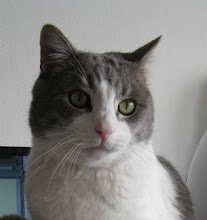I had a good week work-wise this week, I got a few things to work. I also realised that I can pretty much summarise it in pictures.
The first is from something I was playing with the previous Friday afternoon, seeing if I could get the ODE solver in BUGS to work. For this I fitted the Lotka-Volterra equations to some famous data on Lynx-Hare cycles from the Hudson bay Company. I got it working this week, and the model fits reasonably well:
I'm happy with the lynx fit, but the hares aren't great - I might have to add carrots into the model. But considering how simple the model is, it's pretty good.
The second result is something I've been working on for some time, a multi-trait QTL analysis. This is genetics - trying to locate genes that affect different traits. We've been looking at models that can include several traits in the same analysis. Here I plotted what is roughly the probability that each locus (on the x-axis) affects each trait (each line).
Locus 12 seems to be affecting several traits - yes, we have pleiotropy! The numbers aren't totally convincing, but it looks like there's something there.
At the same time, I've also been doing another predator-prey analysis, on voles and weasels. That worked as well, and this is a plot showing that the interactions are local:
The ideas is that if the circles overlap, there is a correlation between the sites. Actually, this interpretation may be a bit dodgy, but the main thing that comes out of this is that most of the sites are behaving independently.
Finally, this Friday's afternoon playing around involved more ODEs, modelling the numbers of butterflies over a season. This was fairly quick to fit, although it could behave better.
It also needs a bit more work on it (hey, it was only about an hour's work!), because there is more variation than the model accounts for.
Other than showing I had a good, interesting week, does this really say anything? One thing is that none of the graphs will look like that in their final versions - these are all produced as part of the process of doing the analysis. But "quick and dirty" graphs are still very useful for looking at the results, and getting a feel for what's happening. It also shows the worth having packages with good, flexible graphing functions - two of the plots are standard BUGS plots, the other two are drawn in R. Plots are also an easy way of showing collaborators what you've done - I've drawn several other plots this week, and not all will end up in the final write-ups of the work.
Now I just have to write all this up.
Saturday, 29 September 2007
My Week in Pictures
Posted by
Bob O'Hara
at
15:58
![]()
Labels: graphs, statistics
Subscribe to:
Post Comments (Atom)

3 comments:
Oh, do you think you could post the LV code and a pointer to the data? (or the data itself) - I mean, this is THE example that is cited in ecology 101 classes across, well, the planet, and it strikes me that this would be highly instructive for those of us trying to bring Bayes into our ecology statistics and modelling classes.
The data is in the GPDD (series 2721 and 2722). I'd like the code to be an example in BUGS, so it'll be available eventually. But at the moment I'm trying to work out if it's worth publishing properly. If not, I'll probably put it up here.
I also want to try and get a better fitting model too!
Bob
Fascinating week! The progress of the data gathering is amazing. Graphic!
Post a Comment